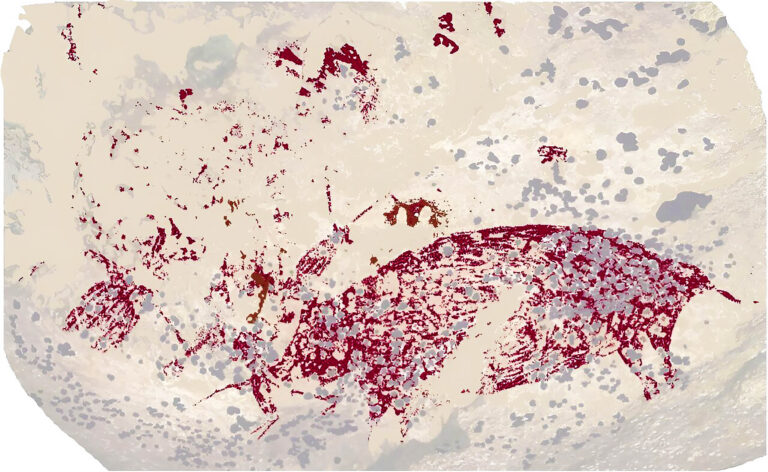Deep inside an Indonesian cave lies a humble piece of art that tells a story dating back more than 51,000 years. Depicting three human-like figures gathered around a big red pig, this remarkable painting is the oldest known piece of narrative art in the world made by human hands.
Titled “Flaked Drawing of Three Figures Surrounding a Big Red Pig,” the painting represents the dawn of human storytelling.
Unravelling time through exquisite art
Scientists from Australia’s prestigious Griffith University made this astonishing discovery.
“This is the oldest evidence we have of a story,” said archaeologist Maxim Aubert of the university, who was part of a research team that previously discovered a 48,000-year-old hunting scene in another Indonesian cave.
But this latest find significantly surpasses the previous record holder: “It’s the first time anyone has broken the 50,000-year barrier,” Obert noted.
The study provides a fascinating glimpse into human cognitive evolution, suggesting that early humans possessed a highly sophisticated level of storytelling ability.
“Our findings suggest that storytelling is a much older part of human history than previously thought,” said archaeologist and co-author Adam Blum.
Pushing the boundaries of laser dating
The ancient artwork was dated using cutting-edge laser ablation technology, which uses lasers and computer software to create a “map” of the rock sample.
This innovative method has proven to be more accurate, efficient and affordable than traditional uranium-series methods, and it also requires significantly smaller rock samples.
The archaeological team first tested this technique on a previously discovered painting of a hunting scene, which experts determined to be at least 48,000 years old, contradicting an earlier estimate of 44,000 years ago.
They then used this new laser method to date cave art in Sulawesi, yielding a remarkable age of 51,200 years.
Images of pigs depicted in cave paintings
One of the interesting features of ancient Indonesian artwork is the depiction of the big red pig, a motif that carries cultural and symbolic meaning.
Pigs were not just a subject of artistic expression; they were an essential part of food and ritual in early human societies.
The choice of pigs for artwork may indicate the importance of pigs in the diet and spiritual practices of the people who created them.
Understanding why early humans chose certain animals for their stories can provide greater insight into their daily lives, beliefs, and interactions with the environment.
Early human migration
This groundbreaking discovery also has important implications for understanding early human migration patterns.
The presence of such sophisticated artwork in Indonesia suggests that the early humans who migrated out of Africa were not only adept at survival, but also had a rich tradition of storytelling and artistic expression.
This challenges the idea that complex cognitive abilities and cultural practices developed only in Europe and the Middle East, and instead highlights the more diverse and widespread emergence of human creativity across different regions.
Future research in other parts of the world may uncover new pieces of this complex puzzle and further our understanding of our common human heritage.
The ancient mystery of cave paintings
Human evolutionary origins can be traced back to Africa over 300,000 years ago. The first known images made by our ancestors are simple ochre lines and patterns found in South Africa, dating back 100,000 years.
This evidence is followed by a “big gap” to the Indonesian cave paintings dating back 50,000 years. Why is there such a gap? Why is art not ubiquitous across the entire human evolutionary timeline?
While some argue that older works of art may simply not have stood the test of time, others believe that relics from a lost era are still out there, patiently waiting to be discovered.
Traditionally, it has been believed that narrative art first appeared in Europe. But Indonesian cave paintings, which are much older than those found elsewhere, including in Europe, are urging us to rethink this idea.
These discoveries are remarkable evidence of human creativity and ingenuity, and a reminder that fragments of our collective past may lie engraved on cave walls or buried beneath layers of history, eagerly waiting for us to unravel their ancient mysteries.
The study has been published in the journal Nature.
Image credit: Griffith University/AFP
Video credit: Southern Cross University
—–
Like this article? Subscribe to our newsletter for more fascinating articles, exclusive content and updates.
Check it out with EarthSnap, a free app brought to you by Eric Ralls and Earth.com.
—–


